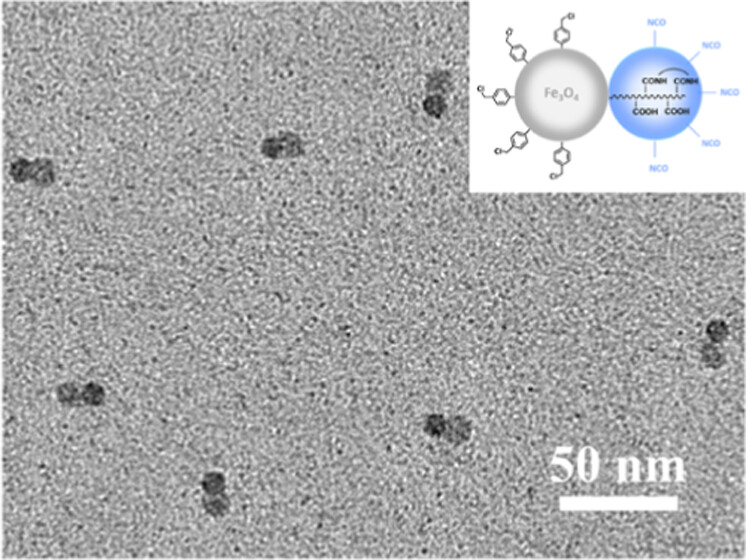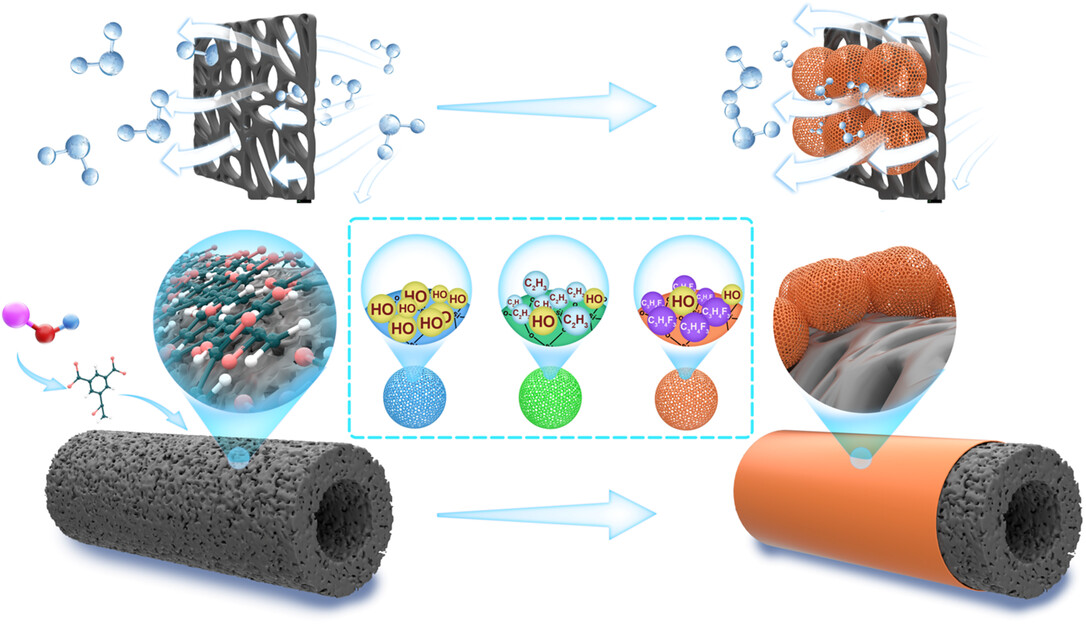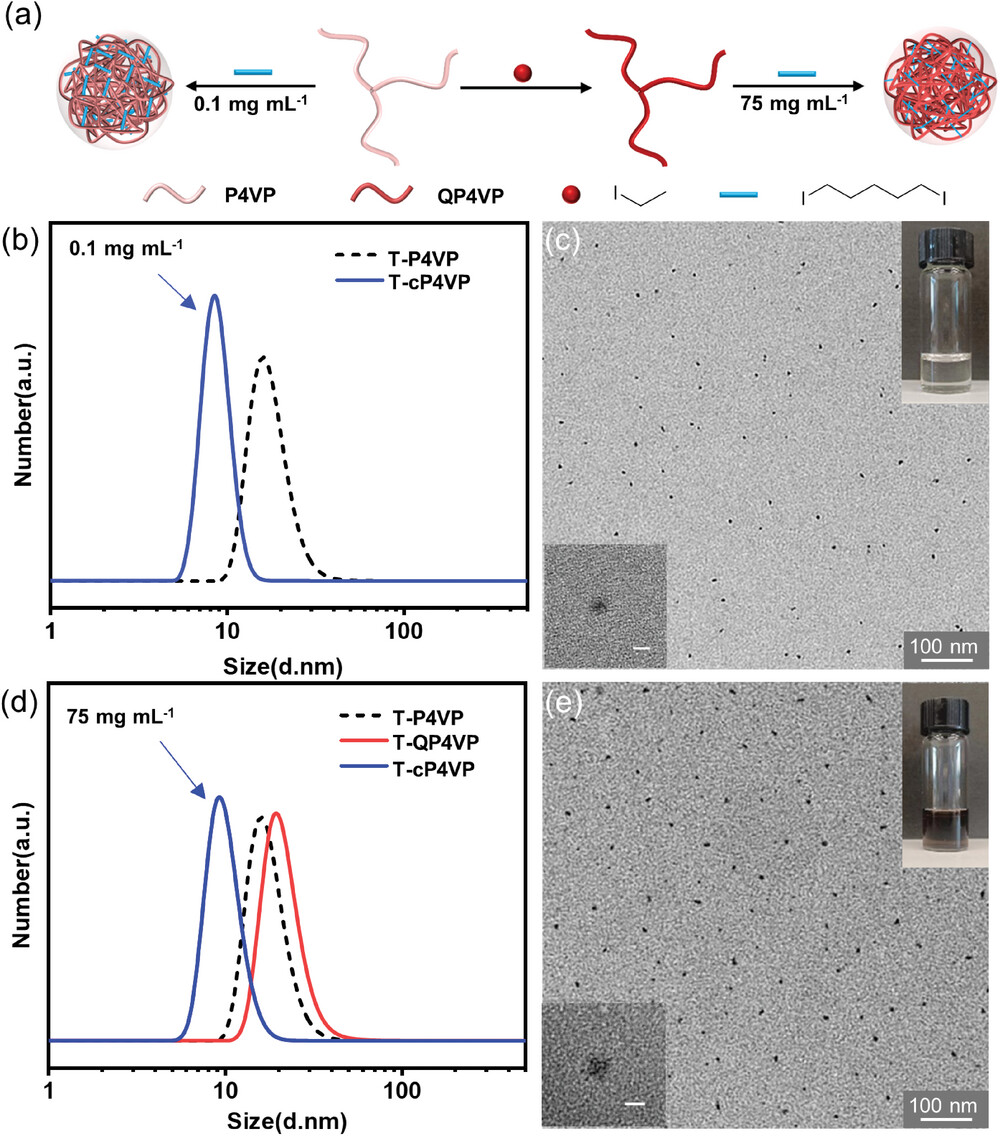Research Articles
1. Yang, Yajing; Li, Fenglin; Sun, Dayin; Ye, Yilan; Yang, Zhenzhong*. Large-Scale Synthesis of Reactive Janus Inorganic/Polymer Colloidal Dimer. Macromolecules, 2024, 57, 880-886.
A new method is proposed to large-scale synthesize reactive Janus inorganic/polymer colloidal dimers by electrostatics-mediated intramolecular crosslinking of the tethered diblock copolymer single-chain of PVSt-b-PmSt at an example inorganic NP of Fe3O4@SiO2. Tethering the single-chain is achieved by terminating the anionic living polymer onto the chloromethylphenyl- group capped NP. While the electrostatic interaction is introduced by complexation of the mercaptoacetic acid (MA) clicked PVSt block with 1-methylimidazole (MI), the intramolecular crosslinking is achieved with 1,6-hexanediisothiocyanate (HDI). The example dimer of cPVSt-b-PmSt-Fe3O4@SiO2 could be synthesized in a highly concentrated dispersion up to 100 mg/mL. The amphiphilic Janus colloidal dimer is effective to manipulate the stabilized emulsion droplets with a magnet. The parent colloidal dimer is highly reactive with residual chloromethylphenyl-, cyanate, and carboxylic acid groups at different sites to assist deriving a family of functional dimers by simple modifications.

https://doi.org/10.1021/acs.macromol.3c02334
2. Feng, Aoxing; Lin, Yakai*; Sun, Dayin; Wu, Fangyu; Wu, Huanhuan; Tang, Yuanhui; Zhang, Fanchen; Jia, Wei; Yu, Lixin; Wang, Xiaolin; Yang, Zhenzhong*. Mesoporous Silica Nanoparticle Grafted Polypropylene Membrane toward Long-Term Efficient Oxygenation. Small Struct., 2025, 6, 2400324.
The trade-off between gas permeability and resistance to plasma leakage imposes a great challenge for the practical use of membranes in extracorporeal membrane oxygenation (ECMO). Herein, a polypropylene (PP) hollow-fiber composite membrane is fabricated by simply grafting mesoporous silica nanoparticles onto the commercial PP membrane, which shows a significantly enhanced gas permeability and superior resistance to plasma leakage. The performance metrics such as gas permeability, bubble point, surface hydrophobicity, and plasma leakage resistance are largely influenced by the type of functional groups on the silica nanoparticles (hydroxyl, vinyl, or trifluoropropyl). It is shown that the trifluoropropyl-group functionalized mesoporous silica nanoparticle grafted composite membrane demonstrates a superior performance than the commercial ECMO membrane of poly(4-methyl-1-pentene) (PMP). The bubble point is greatly elevated from 0.36 to 1.20 MPa while the decrease in gas flux is negligible within 4%. And the leakage resistance time is significantly prolonged from 600 to 4140 min. The gained benefits are originated from the enhanced mass transfer area and diminished surface pores of the composite membrane are grafted with the mesoporous nanoparticles. The high-performance PP-based composite membranes are cost-effective and promising in practical applications of ECMO.

https://doi.org/10.1002/sstr.202400324
3. Li, Shuailong; Sun, Shuyi; Luo, Jiaqiu; Xia, Zhiqin; Wang, Yaxin; Thomas, P. Russell; Shi, Shaowei*; Yang, Zhenzhong*. Polymer Single-Chain Nanoparticles: Shaping Solid Surfactants. Macromol. Rapid Commun., 2024, 45, 2400393.
Polymer single-chain nanoparticles (SCNPs) have found a wide range of applications spanning catalysts, sensors and nanomedicine. The generation of structured SCNPs from star-shaped polymers with diverse architectures and functionalities affords a new avenue to expand the emerging research area. The large-scale synthesis of structured SCNPs is described by the electrostatics-mediated intramolecular crosslinking of three types of 3-armed star-shaped polymers (T-P4VP, T-PS-b-P4VP, and T-P4VP-b-PS), whose configuration is tunable from spherical to cage-shaped to dumbbell-shaped and star-shaped. The structured SCNPs are amphiphilic and can be used as solid surfactants to stabilize different types of emulsions.

https://doi.org/10.1002/marc.202400393
4. Li, Fenglin; Yang, Yajing; Wen, Zhendong; Sun, Dayin; Ye, Yilan; Yang, Zhenzhong*. Organization of A2-Type Active Composite Nanorods. Macromol. Rapid Commun., 2024, 45, 2400563.
Nanorods as building blocks are promising to construct functional superstructures. A paramagnetic Fe3O4-based composite nanorod is large-scale synthesized from the poly(2-vinylpyridine) (P2VP) side chain grafted polymer bottlebrush by electrostatics-mediated intramolecular crosslinking via metallic coordination. Ultrasonication-assisted fracturing of the composite nanorod derives the corresponding A2-type composite nanorods whose two ends are active with the metallic coordinated P2VP exposed. The active ends are prone to connection upon feeding ligands (acidic or alkaline) or metallic ions to trigger the organization of the A2-type nanorods toward functional superstructures. Their microstructure is tunable from linear nanowires to branches, which is dependent on the valent state of the assistant chemicals. The report method is easily extended to derive a family of A2-type active nanorods with varied compositions and functions which are capable to organize functional nanomaterials with tunable microstructure.

https://doi.org/10.1002/marc.202400563